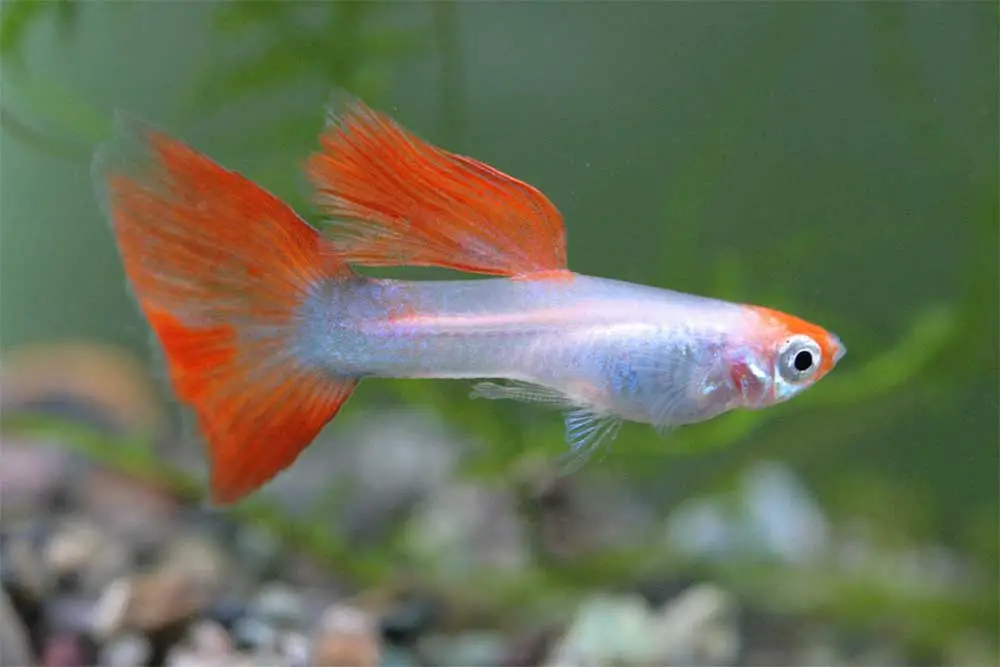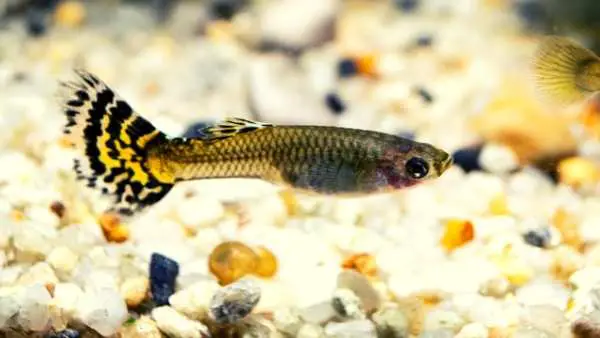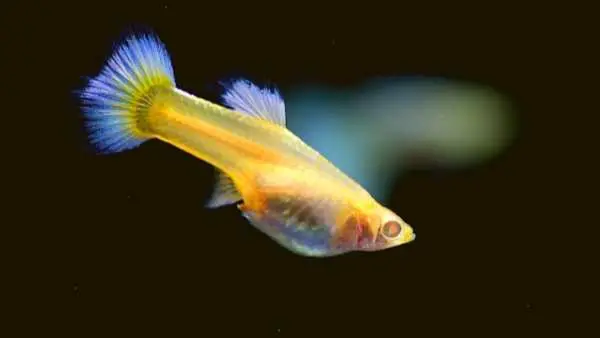Guppies are a very interesting breed of fish. They are incredibly small, live bearing freshwater fish that have become very popular as pets and in aquariums. The guppy is a relatively easy fish to care for, being very hardy, low maintenance, and easy to keep alive.
As long as you keep the tank clean, provide them with food and a little TLC, your guppies will be happy and thriving for a long time.
However, guppies can reproduce very easily and quickly, as the average female guppy can give birth every 30 days! So, you will need to keep an eye on your guppies, and be able to check if your guppy is pregnant.
Fortunately, this guide will walk you through exactly what a guppy fish is, how to tell the sex of your guppies, and what signs to look out for to see if they are pregnant.
If you have a pregnant guppy, we can also help you find out how to care for them and what to expect when the big day arrives!
What is a guppy?

A guppy is a very small freshwater fish that is often kept in aquariums and tanks across the world. However, these types of fish are typically native to tropical areas of America. Guppies come in all shapes, colors and sizes, which is why they are often known as rainbow fish!
They are some of the most popular fish available, due to their pretty colors and easy to care for nature. A guppy fish is known for being very low maintenance, as they eat pretty much anything and are happy in a clean environment that they can swim around in and explore.
However, guppies are also known for their ability to mate, anytime, anyplace, with anything. Female guppies are capable of bearing up to 2,000 young in their lifetime, and breed constantly.
Guppies are also what is known as live-bearing fish, which means that they are able to give birth to fully formed young, that can swim straight away.
Due to their nature of always mating, or being pregnant, you will need to be able to identify when your guppies are pregnant. The first step in this process is to find out whether your guppy is male or female.
How to check if your guppies are male or female
As previously mentioned, guppies are incredibly fertile fish, and can get pregnant every 30 days, which is why many people can unknowingly purchase a female guppy from a store that is already pregnant.
It is for this reason that you should be capable of identifying a pregnant guppy so that you do not have a few uninvited guests!
A young guppy can start to breed when it is as young as one month old, as the gender of a guppy tends to develop around the 4 week mark.
At six weeks old, a guppy is then sexually active, and ready to start mating and breeding. For most guppies, the first breeding time will be between the ages of three and five months old.
As stated above, guppies will try to mate all the time, and so if you have a male and a female guppy in your tank, then they are probably about to become parents!
This is why you have to be aware of the gender of your fish, or you will end up with hundreds of guppies over and over again.
To see whether your guppies are male or female, you will need to take a look under the guppy’s tail and towards the back end of the stomach. This is where you will find the anal fin, and you should see if the fish has a dark patch called a gravid patch. If it does, then the fish is female.

If you have both male and female guppies, then you should keep them in separate tanks until you are prepared to breed them, as female guppies can become pregnant over and over again.
They can even become pregnant a few hours after giving birth, and can store sperm ready for insemination for up to a year after mating!
Keep in mind that the average number of fry born at a time is about 30-60, but some guppies can give birth to 200 fry from one single pregnancy.
Guppy breeding characteristics
The good news is that you will be able to tell when your guppies are about to mate. This is because the male guppies become frantic, chasing the female guppies around the tank hoping to mate and breed.
Some of the characteristics you may need to watch out for is aggression. Some males seem like they are being aggressive, but they are probably just trying to mate quickly.
When a male is close enough to a female guppy, he will try to extend the gonopodium, and then pass the sperm onto the female’s anal vent near the gravid spot. The whole mating process is very quick, but some guppies can mate multiple times to ensure that insemination has taken place.
How long is the guppy gestation period?
If you have discovered that your guppy fish is pregnant, then you may be wondering when you can expect a few little bundles of joy to come along.
Luckily, the gestation period of a female guppy fish is not long at all, and you can expect guppies to be born anytime between 21 and 30 days after the fish becomes pregnant. Something to also keep in mind is that guppy rest and sleep play massive factors in how quickly your female guppy will reproduce.
If you do notice that one of your female guppy fish has become pregnant, then you should remove her from the tank immediately, and place her in a separate, isolated breeding tank.
How to identify a pregnant guppy
If you are unsure if your guppy fish is pregnant, then there are a few telltale signs that you can look out for. The biggest and most obvious way that you can tell if your guppy is pregnant is if the gravid spot looks different in any way.
Some female guppies will have a gravid spot that appears much darker than normal, and may grow much larger than usual.
As the babies develop and grow when the guppy is pregnant, you will see that the gravid spot grows larger, more pronounced, and much darker in color. The female guppy may also grow considerably, or become less colorful herself.
As the pregnancy progresses, you will notice that the gravid spot becomes almost black in color entirely, and you may even be able to see the babies inside the belly through the skin of your guppy.
You will also notice a few changes in your guppy’s behavior. A pregnant female guppy fish will tend to be a bit more lethargic, not as active, and she may try to hide or stay in one place.
In addition to this, pregnant guppies can sometimes either become very shy or more aggressive than usual. Therefore, if you notice some drastic changes in your guppy’s behavior, then it may be a sign that she is pregnant.
As the guppy approaches the time to give birth, she may also begin eating more, and she could have some difficulties whilst swimming. As the labor progresses, you will notice that she is pushing and her back is arching, ready to release the babies.
How to care for a pregnant guppy
When your guppy fish is pregnant, it is a good idea to start preparing, and you will need to maintain your tank differently. For instance, it is recommended that you use a 10 gallon breeding tank, to keep the pregnant fish away from the other fish in the tank.
In addition, you should set up two different tanks, one for the fry to be born in, and one for the female fish to recover in, after birth. This is typically what you will need to do for other pregnant fish that you own.
You should also be maintaining the water at a pH level of about 7.0 and 7.6, whilst also ensuring that the tanks are cleaned regularly, for the best conditions.
You should keep the water clean with a sponge filter, and maintain a water hardness of about 7 to 12 dGH.
To help the birth along and the growth of the fry, try to keep the water temperature between 77 degrees fahrenheit and 79 degrees fahrenheit, and make sure that there are no fluctuations in the temperature so that your pregnant fish does not get stressed.
In addition to this, the guppy fry will need about 8-12 hours of light per day to help them develop properly, so it is worth investing in a tank LED light with a timer to simulate sunrise and sunset conditions for healthy, growing fish.

It is vital that you keep the fry separate from the main tank with the rest of your fish, and keep them away from the mother initially as some fish will try to eat the fry. It is best to place them in a separate tank, but you can purchase mesh netting to keep them safe from other fish.
Feeding a pregnant guppy
If you have a pregnant guppy, you will need to care for her a little differently than normal. For instance, as the pregnant guppy approaches the time to give birth, her appetite will probably lessen, and she will need smaller meals every day.
Try not to leave leftover fish food in the tank, as she should be able to finish all the food you give her in about 5 minutes. Anything leftover once she is done should be removed from the tank.
Just as other animals need extra nutrition when pregnant, guppies are no different. A pregnant female guppy will benefit from good quality flake food, along with some live or frozen foods such as daphnia, mosquito larvae, brine shrimp, spirulina flakes or vegetables like lettuce or zucchini.
The birth of a guppy
The surprising thing is that the birth can take anywhere from two to six hours, and the process can even extend over a longer period of time if needed. In some cases, births that take a very long time can result in non viable fry.
When the fry are actually born, the guppy fry may be curled up into tiny balls. If the fry are healthy, then they will uncurl and begin swimming away very quickly. However, if they are not healthy, or if the fry are stillborn, you will notice them sink to the bottom.
If this is the case, then you should remove the unhealthy fry from the tank as soon as possible, as it is dangerous for other fish to eat them.
Once the female has given birth, you will need to separate her in case she tries to eat the fry herself. It is best to isolate the mother for 1-2 days, keeping her well fed and nourished so that she has no inclination to eat the babies.
It is best to give her a wide variety of high nutrient and rich foods so that she regains her strength. Then, you can return her to the main tank, but keep an eye on her as she can become pregnant again very easily.
Caring for a fry
The fry will also need to be fed good foods such as baby brine shrimp and pulverized flakes. Feed the fry very often, as they can eat small sized meals up to five times a day! After the fry grow to about half an inch in length, they are ready to be introduced to the main tank!

